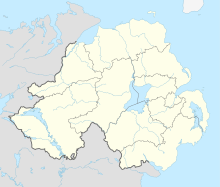RAF Bishops Court
|
RAF Bishops Court |
|||||||||||||||||||
|---|---|---|---|---|---|---|---|---|---|---|---|---|---|---|---|---|---|---|---|
| Summary | |||||||||||||||||||
| Airport type | Military | ||||||||||||||||||
| Owner | Ministry of Defence | ||||||||||||||||||
| Operator | Royal Air Force | ||||||||||||||||||
| Location | Downpatrick, County Down | ||||||||||||||||||
| Built | 1943 | ||||||||||||||||||
| In use | 1943-1990 | ||||||||||||||||||
| Elevation AMSL | 30 ft / 9 m | ||||||||||||||||||
| Coordinates | 54°18′20″N 005°34′09″W / 54.30556°N 5.56917°WCoordinates: 54°18′20″N 005°34′09″W / 54.30556°N 5.56917°W | ||||||||||||||||||
| Map | |||||||||||||||||||
| Location in Northern Ireland | |||||||||||||||||||
| Runways | |||||||||||||||||||
|
|||||||||||||||||||
RAF Bishops Court is a former Royal Air Force airfield, radar control and reporting station located on the south east coast of Northern Ireland, approximately 5.8 miles (9.3 km) from Downpatrick, County Down, Northern Ireland and 24.7 miles (39.8 km) from Belfast, Northern Ireland. A Marconi Type 84 radar was located on the airfield and a Type 80 radar was located at Killard Point, Ballyhornan (remote from the station itself). A Type 93 mobile radar was also located on the airfield from 1989 until the station closed.
A number of different units were based at the airfield:
RAF Bishops Court formed part of the UK Military Air Traffic Service, as one of four reporting stations it was to control its sector (North Atlantic) and was commanded by HQ Military Air Traffic Operations (MATO) at RAF Uxbridge and RAF Strike Command at High Wycombe. The site was known as Ulster Radar and had both a military and civil role. In its civil role the civilian personnel (using the military radar) controlled air traffic, primarily over the Atlantic to ensure correct height and separation.
The Irish Republican Army fired five mortar bombs at the radar site on 11 September 1989.
The responsibilities of the site were assumed by the air traffic control centre at Prestwick, Scotland, in October 1978. The radar equipment was soon removed from the site, however the RAF remained. In the early 1980s new bunkers were constructed and a mobile radar was installed. The decision to close the 577 acre (2.3 km²) site was taken in the late 1980s and it was put up for sale in the period 1991–1995.
Alexander Galt the famous Scottish artist was stationed here during the war. While there he painted murals on the wall of the officers mess. The paintings are still visible.
Since the sale the land surrounding the runway has been used for agriculture, while the land at one end of the site (including some of the airfield runways) has been used for motor sport being called Bishopscourt Racing Circuit. Today at least one runway remains intact and is used by gliders, the married quarters are now civilian housing.
...
Wikipedia

